Back
In the West, a healthy meal generally contains a balanced ratio of fats, proteins, and carbohydrates with bonus points for color and not too much added sugar, salt, or saturated fat.
There are, of course, many variances on this theme.
But the point is Western nutrition generally focuses on macronutrients—be it low-fat, low-carb, low-sugar, high-protein, high-fiber, low-calorie, etc.—and portion control.
Ayurvedic nutrition takes a very different approach by focusing on the 6 tastes of Ayurveda (known as ‘Rasas’):
They are: Sweet, Sour, Salty, Bitter, Pungent, Astringent
Each taste is born of the five elements: Water, Air, Earth, Fire, and Ether (space).
Instead of building a meal around protein, fat, carbohydrates, and fiber, the ancient Vedics recommended including all six tastes in every meal, in the order listed above, and in portions suited to one’s specific Dosha.
This practice deeply nourishes the entire person, body, mind, and spirit while creating satiety and an appreciation and reverence for healthy, whole foods.
In this article, we’ll do a deep dive into these six tastes of Ayurveda, including descriptions, examples of foods, herbs, and spices, how they relate to different doshas and the five elements, and the order of eating principle.
If you’re curious about Ayurvedic nutrition, this article is the perfect primer.
Table of Contents:
- The 6 Tastes of Ayurveda
- Madhura (Sweet)
- Amla (Sour)
- Lavana (Salty)
- Tikta (Bitter)
- Katu (Pungent)
- Kashaya (Astringent)
- 6 Tastes Elements
- 6 Tastes Effect on Doshas
The 6 Tastes of Ayurveda
Westerners tend to think of tastes in terms of Sweet, Salty, Bitter, and Sour.
Ayurveda recognizes all these Tastes plus two others: Pungent and Astringent.
Let’s examine these Six Tastes of Ayurveda in order of recommended consumption (more on this later) and how they support the health of body, mind, and spirit.
Note: Most foods, herbs, and spices contain one or two primary tastes, but some, like Triphala or Cardamom, contain several.
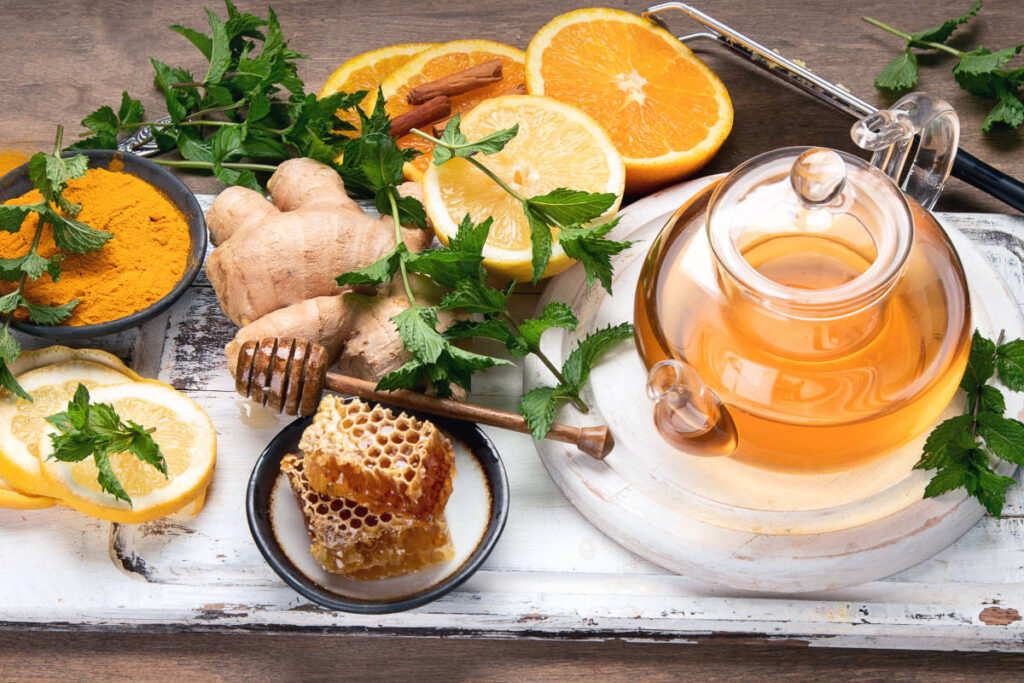
1. Madhura (Sweet)
Little description is needed to describe this first Taste.
Humans are hard-wired to love sweet foods.
From our first taste of naturally sweet breast milk or sweetened formula to fruits and more complex sweet flavors, it seems nature has programmed us to seek out Madhura (sweet) flavors.
In ancient Ayurvedic texts, naturally Sweet foods are considered very important and are recommended to come first in a meal.
Although too much very Sweet food, such as refined sugars or artificial sweeteners, can be detrimental, natural Sweetness in various foods is essential to taste and good health.
Some examples of sweet foods, herbs, and spices in Ayurveda include:
- Basil, including Tulsi
- Cardamom
- Cashews
- Cinnamon
- Clove
- Dates
- Fennel
- Maple syrup
- Milk
- Nutmeg
- Licorice
- Sugars
- Rice
- Rose
- Pumpkins and sweet squashes
- Triphala
- Wheat
Sweet foods promote:
- Healthy blood plasma
- Healthy tissues
- Healthy nervous system function
- Brain function
- Longevity
- Strength
- Stamina
Sweet foods are recommended for:
- Those who are underweight
- Children
- The elderly
- The weak or recovering
Excessive consumption of Sweet foods, even naturally sweet foods, can result in:
- Excess mucus
- Slow digestion
- Lack of energy
- Sluggishness
- Weight-gain
The Sweet taste is also considered the most sattvic (sattva being a pacifying energy that brings us peace and tranquility). It helps us cultivate and practice love, compassion, and peacefulness when consumed in balanced amounts.
Although naturally Sweet foods can benefit every dosha in the right amounts, they tend to be most beneficial for Pittas.

2. Amla (Sour)
The Sour taste also needs little explanation.
Opposite of Sweet, though often complementary or experienced within sweet foods, these are the acidic foods that make us pucker while enhancing the production of saliva and bringing brightness to foods and beverages.
Examples of Sour foods, herbs, and spices in Ayurveda include:
- Alcohol
- Amla (also known as Amalaki or Indian Gooseberry)
- Butter
- Cheese
- Cherry
- Cranberry
- Garlic
- Grapefruit
- Jujube
- Haritaki
- Hawthorn Berry
- Kombucha
- Lemon
- Lime
- Pickles
- Raisin
- Peaches
- Pomegranate
- Rhodiola
- Savory
- Schisandra
- Sourdough breads
- Tamarind
- Tomato
- Triphala
- Vinegar
- Yogurt
Sour foods promote:
- Bile flow
- Digestion and elimination
- Energy
- Feeling grounded and organized versus scattered and disorganized
- Healthy heart function
- Moistness throughout the body
- Normal flow of gastric juices
- Liver function
- Metabolism
- Normal expulsion of mucus
- Saliva production
Sour foods may be recommended to support:
- Bile flow
- Constipation
- Dryness of mouth or throat
- Energy
- Focus
- Gallbladder function
- Liver function
- Metabolism
- Pancreatic function
- Salivary production
- Sluggish digestion
Excess consumption of Sour foods may lead to:
- Congestion
- Digestive discomfort
- Excess thirst
- Ear, eye, and/or teeth sensitivity
- Excess drying of mucous membranes
- Itching
Sour foods are also believed to help revive or awaken our thoughts and emotions, much like a drizzle of lemon or lime juice can awaken the flavors in a recipe.
Different types of Sour foods (ferments vs citrus, for example) affect the doshas and organs differently. However, they are generally best tolerated by Vatas.
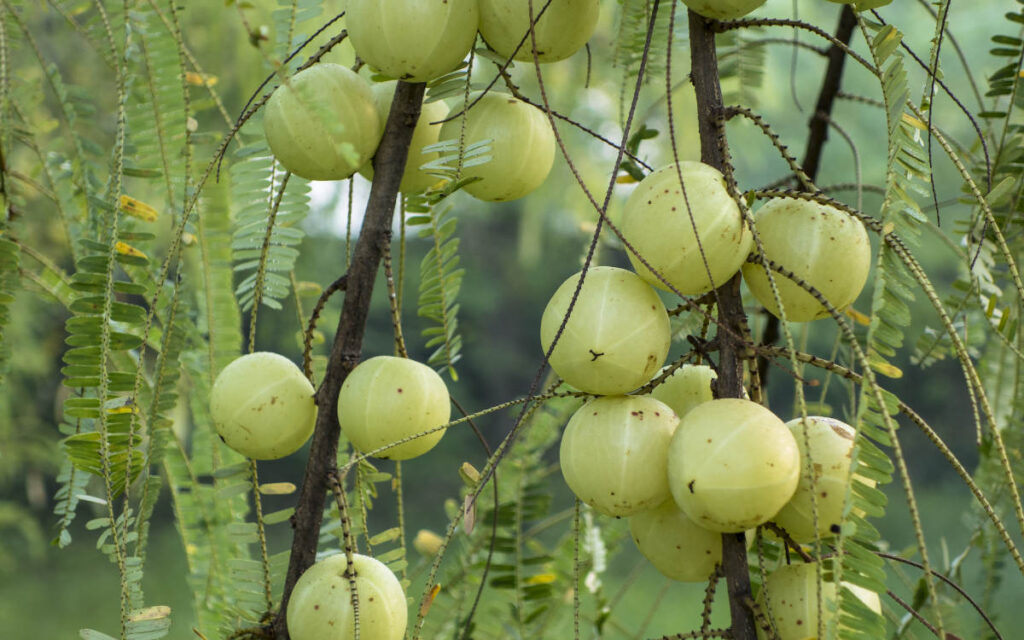
3. Lavana (Salty)
We’re all familiar with Salty foods, which can have the same addictive quality as refined sweets.
However, in Ayurveda, the Lavana/Salt taste is not limited to foods seasoned with sea salt but also those rich in minerals.
When taken in small amounts, Salty foods help stimulate the production of fluids, keep the body moist and warm, aid in nutrition absorption, ground the mind and body, and help maintain electrolyte balance.
Examples of Salty foods, herbs, and spices in Ayurveda include:
- Alfalfa sprouts
- Any food with added salt
- Bee Pollen
- Black Cohosh
- Celery
- Dairy, such as cheeses
- Echinacea
- Gravel Root
- Nettles
- Olives
- Plantain
- Seafood
- Sea vegetables
- Shilajit
- Soy sauce
- Spirulina
- Tuna
Salty foods, in balanced amounts, promote:
- Appetite
- Creativity
- Detoxification
- Digestion
- Electrolyte balance
- Elimination
- Inspiration
- Fat metabolism
- Muscle function
- Lubrication of joints and tissues
- Moistening of bodily fluids
- Nervous system function
- Stable mood and spirit
- Urinary/kidney function
Salty foods may be recommended to support:
- Bile flow
- Constipation
- Dryness of mouth or throat
- Energy
- Focus
- Gallbladder function
- Liver function
- Metabolism
- Pancreatic function
- Salivary production
- Sluggish digestion
Excess consumption of Salty foods may lead to:
- Blood issues
- Excess heat
- Heart conditions
- High blood pressure
- Loss of libido
- Excess thirst
- Kidney ailments
- Skin conditions
When used in small to moderate amounts, Salt helps bring recipes alive, stimulate the taste buds, nourish the blood, and support digestion and detoxification.
Vatas can generally tolerate more salt than Pitta or Kaphas.
It has a calming, uplifting, and inspiring effect on the mind and spirit and is also used in many Ayurvedic body treatments as a detoxifier.
Note: Ayurveda only recommends using natural salt, such as sea salt, Himalayan salt, black salt, Celtic salt, etc. vs. table salt.

4. Tikta (Bitter)
Bitter is often an acquired taste, yet Bitter foods and herbs are considered essential in most traditional wellness systems, including Ayurveda.
It is believed people tend to reject Bitter foods due to evolutionary programming, which tells us to avoid bitter tastes because they tend to be toxic.
Although this is true of many plants, other “Bitters,” such as leafy greens, radishes, and herbs, have been traditionally used for centuries to support various aspects of well-being, especially digestion and liver/gall bladder function.
Examples of Tikta/Bitter foods, herbs, and spices in Ayurveda include:
- Aloe
- Arugula
- Artichoke
- Bitter Melon
- Burdock Root
- Caraway
- Cardamom
- Cassava
- Chamomile
- Coriander
- Coffee
- Cumin
- Dark leafy greens like kale, mustard greens, and collards
- Dark chocolate
- Dandelion
- Dill
- Eggplant
- Fenugreek
- Green and black teas
- Jerusalem artichoke
- Triphala
- Saffron
- Sesame seeds and oil
- Turmeric
Bitter foods, in balanced amounts, promote:
- Appetite
- Bile flow
- Detoxification
- Digestion
- Elimination
- Fat metabolism
- Muscle tone
- Skin health
Bitter foods may be recommended to support:
- Bile flow
- Bloating
- Blood health
- Clearing of mucus
- Constipation
- Detoxification of body, mind, and spirit
- Drainage of excess moisture
- Energy
- Feelings of clarity and self-awareness
- Focus and concentration
- Gallbladder function
- Healthy plasma
- Introspection
- Gallbladder function
- Liver function
- Metabolism of fats
- Nervous system function
- Normal cholesterol
- Optimal weight
- Reproductive function
- Sluggish digestion
- Wound healing
Excess consumption of Bitter foods may lead to:
- Detoxification symptoms due to too rapid detoxification
- Excess dryness/depletion of fluids
- Nausea
- Reduced libido
- Skin issues
Bitter foods can be especially helpful for Kapha and Pitta.
In a world overrun with Sweet and Salty foods, bringing some Bitter taste into your life can have a tangible effect on your digestion, elimination, mood, detoxification pathways, and even your weight.
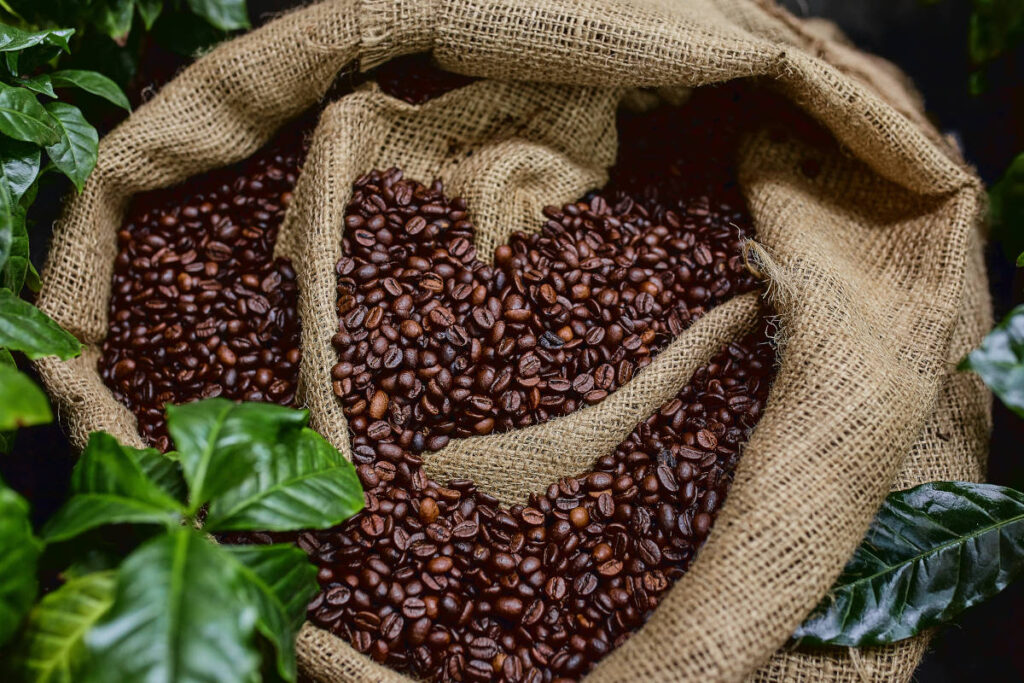
5. Katu (Pungent)
Katu or Pungent isn’t a familiar term used to describe flavor in the West. And if it is, it isn’t typically used with fondness.
However, in Ayurveda, it relates to hot, dry, and intensely spicy foods.
Pungent foods detoxify, warm, and stimulate while bringing great flavor and even a hint of euphoria to various dishes.
Examples of Pungent foods, herbs, and spices in Ayurveda include:
- Black pepper
- Buckwheat
- Cardamom
- Cayenne
- Chilis
- Garlic
- Ginger
- Hard liquor
- Kohlrabi
- Leeks
- Mustard seeds
- Mustard greens
- Onions
- Paprika
- Radishes
- Raw spinach
- Spelt
- Triphala
- Turnips
- Watercress
Pungent foods, in balanced amounts, promote:
- Appetite
- Circulation
- Clarity of mind
- Clear airways
- Detoxification
- Desire
- Digestion
- Elimination
- Energy
- Fat metabolism
- Movement of prana (energy)
- Nutrient absorption
Pungent foods may be recommended to support:
- Circulation
- Cleansing of blood and muscles
- Detoxification
- Heart function
- Immune function
- Liver function
- Libido
- Metabolism of fats
- Mucous removal
- Optimal weight
- Reproductive function
- Sinus function
- Sluggish digestion
- Wound healing
Excess consumption of Pungent foods may lead to:
- Excess thirst
- Excess heat
- Digestive discomfort
- Fatigue
- Mental agitation
- Nervous system issues
- Reproductive issues
- Sleeplessness
Pungent tastes are considered expansive and fast-acting on all bodily systems.
They’re especially helpful for Kaphas and those with a propensity to coldness and lack of digestive fire.
Pungent foods also help inspire feelings of excitement, curiosity, and vigor.
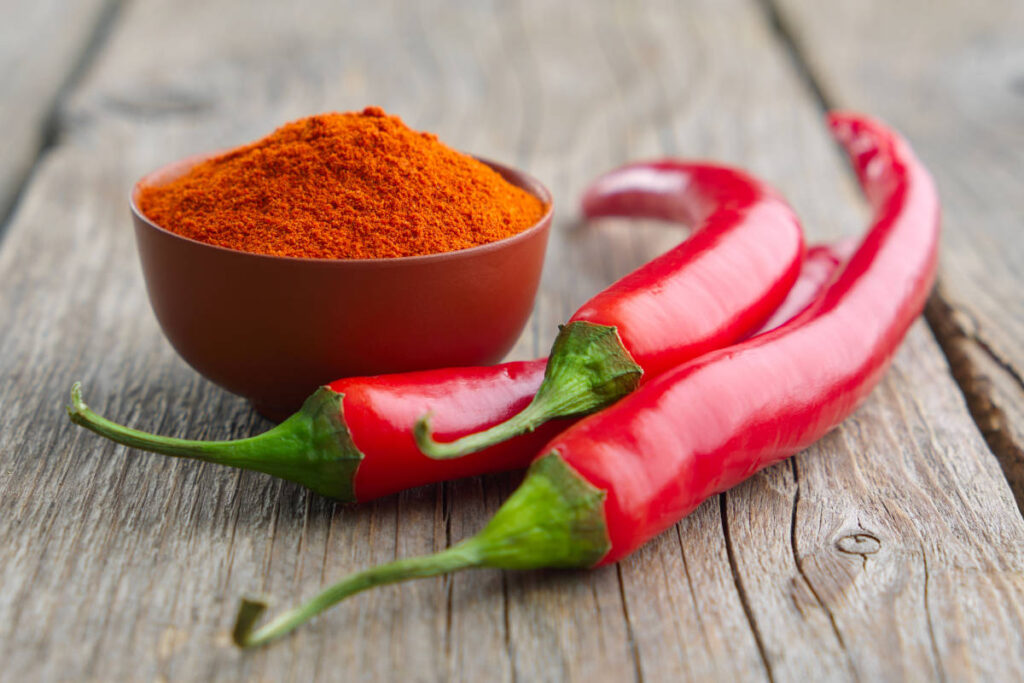
6. Kashaya (Astringent)
The Kashaya or Astringent taste is one of the 6 tastes of Ayurveda that can be elusive if you’re unaware of it or not used to seeking its flavor.
Astringent foods have a drying effect in the mouth that causes a contraction of the mucus membranes in the mouth, leading to a chalky or puckering sensation.
Many bitter and sour foods are also Astringent but also maintain that drying quality.
Examples of Kashaya/Astringent foods, herbs, and spices in Ayurveda include:
- Alfalfa sprouts
- Amalaki
- Apples
- Avocado
- Basil
- Bay leaf
- Black or green tea
- Green bananas
- Most beans and legumes
- Cabbage
- Carrots
- Caraway
- Cauliflower
- Coriander
- Cranberries
- Dill
- Grapes
- Green beans
- Lettuces
- Light meat chicken
- Marjoram
- Nutmeg
- Oregano
- Parsley
- Peas
- Pomegranates
- Potatoes
- Rhubarb
- Rosemary
- Rye
- Saffron
- Triphala
- Turmeric
- Walnuts
- Wheat pasta
- Vanilla
- Venison
- Zest of citrus fruits
Astringent foods, in balanced amounts, promote:
- Absorption of excess moisture or dampness
- Detoxification
- Healthy muscle, organ, and skin tone
- Elimination
- Fat metabolism
- Normal sweating
- Nutrient absorption
- Urinary function
Astringent foods may be recommended to support:
- Detoxification and cleansing
- Digestion and elimination
- Healthy formed bowels
- Clear airways and respiratory function
- Inflammatory response
- Nausea
- Optimal weight
- Organized thoughts
- Normal fluid retention
- Normal sweating
Excess consumption of Astringent foods may lead to:
- Digestive complaints
- Excess thirst
- Constipation
- Dry skin or mouth
- Nervousness
- Reduced libido
- Sleeplessness
Astringent tastes are a part of many different foods and are considered very drying.
While this can benefit some people, especially Pitta or Kapha, this taste is best enjoyed in moderation.
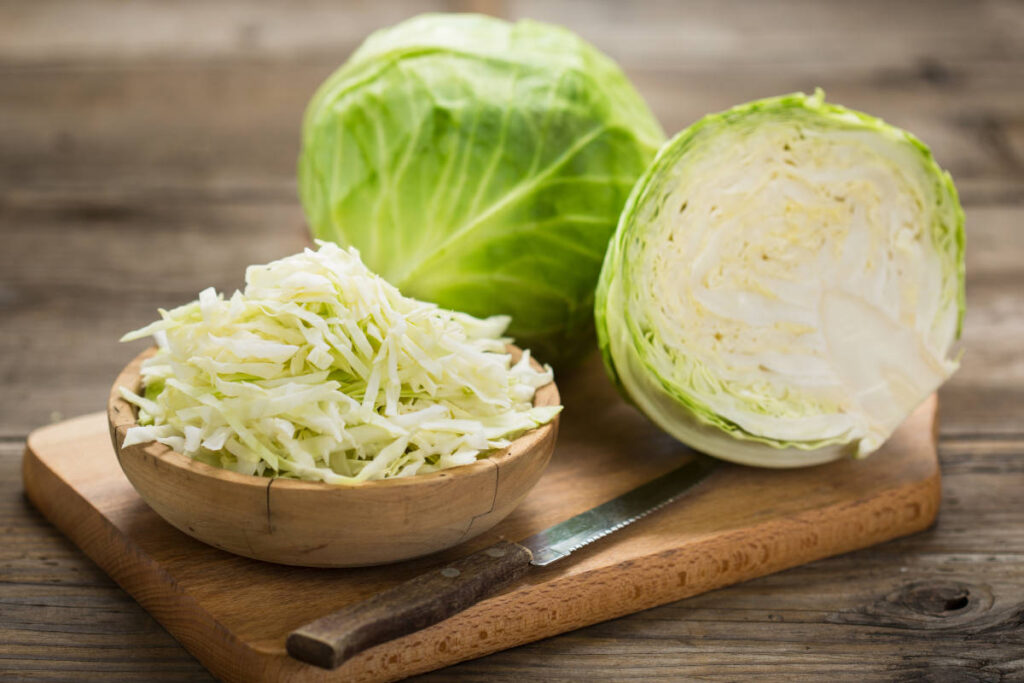
6 Tastes of Ayurveda Elements
As mentioned in the introduction, the six tastes of Ayurveda are born from the five elements:
- Water
- Air
- Earth
- Fire
- Ether (space)
Here are the primary elements relating to the six tastes:
- Madhura’s/Sweet’s elements are: Earth and Water
- Amla’s/Sour’s elements are: Earth and Fire
- Lavana’s/Salty’s elements are: Water and Fire
- Katu’s/Pungent’s elements are: Fire and Air
- Tikta’s/Bitter’s elements are: Air and Ether (space)
- Kashaya’s/Astringent’s elements are: Air and Earth
Even with a basic understanding of the 6 tastes of ayurveda, one can see how these elements lend themselves to the tastes.
For example, Water can have a sweetness and/or a salty or mineral flavor; Fire naturally relates to the dryness and spice of Pungent and Sour; and Ether relates to the cleansing action or “making space” of Bitters.
What is the Order of Eating in Ayurveda?
In Ayurveda, when we eat is just as important as what and how we eat for supporting or diminishing Angi (digestive fire).
Ayurveda recommends eating meals at consistent times of the day, with lunch being the largest meal, and avoiding snacks in between meals, which weakens Agni (digestive fire).
In terms of the six Tastes, although it is recommended we try and incorporate all Tastes into every meal, it is best to enjoy the Sweet tastes first to optimize digestive fire.
Effect of the 6 Tastes of Ayurveda on Doshas
Ayurveda has always taken an individual approach to wellness.
This is evident in the nutritional principles, which consider how the six tastes may affect different Doshas.
As we touched on the Taste sections above, although a balance of Tastes supports optimal nutrition and health for everyone, not every Dosha benefits equally from the same quantity of Tastes.
The Tastes will either pacify (balance) or aggravate the person based on their unique Dosha.
Here’s a quick reference as to how the 6 Tastes affect different Doshas:
Madhura/Sweet
- Pacifies Vata and Pitta
- Aggravates Kapha
Amla/Sour
- Pacifies Vata
- Aggravates Pitta and Kapha
Lavana/Salty
- Pacifies Vata
- Aggravates Pitta and Kapha
Katu/Pungent
- Pacifies Kapha
- Aggravates Pitta and Vata
Tikta/Bitter
- Pacifies Pitta and Kapha
- Aggravates Vata
Kashaya/Astringent:
- Pacifies Pitta and Vata
- Aggravates Kapha
How To Incorporate The 6 Tastes of Ayurveda into Every Meal
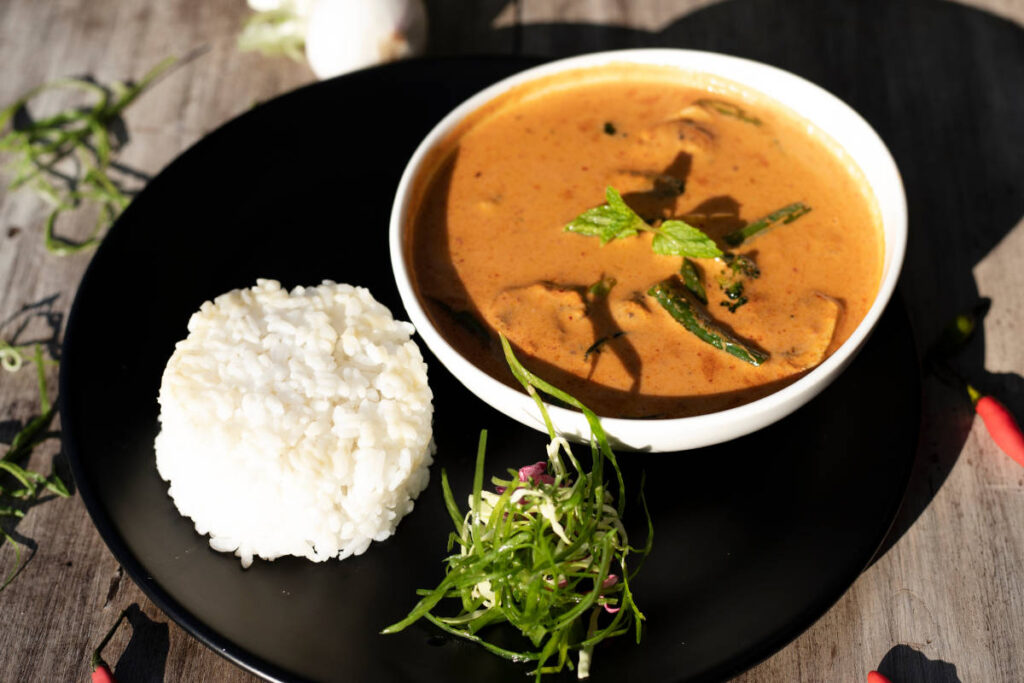
At first, it may seem daunting to figure out how to add 6 Tastes of ayurveda to every meal, especially Pungent, Bitter, and Astringent, which aren’t part of the typical Western diet.
However, the easiest way to do this is to focus on variety, adding spice, and supplementing when appropriate.
Ayurvedic practitioners are big proponents of warm and well-spiced foods. Not only are they delicious, but they naturally incorporate the six Tastes.
That doesn’t mean your food has to be overly spicy, but adding different Pungent, Bitter, and Astringent spices, even in small quantities, is an easy way to elevate your meals.
For example:
- Cardamom is Pungent and is delicious added to your morning oatmeal or applesauce
- Bay Leaves are Astringent and can be added to grains, soups, broths, and stews
- Dill and Cumin are considered bitter and can be added to various dishes and dressings
The Ayurvedic supplement Triphala, one of the most ancient and revered traditional formulas, is another excellent way to enhance Tastes with meals as it contains five out of six: Sweet, Sour, Pungent, Bitter, and Astringent.
Drinking herbal teas, like:
- Tulsi (Sweet),
- Nettles (Salty),
- Hibiscus (Sour), Like Tulsi Hibiscus
- Chamomile (Bitter), like Tulsi Chamomile Honey
- Ginger (Pungent), like Tulsi Lemon Ginger
- And Green Tea (Astringent), like Tulsi Green Tea
With meals is another blissful way to stoke digestive fire and incorporate the 6 tastes of Ayurveda.
Craving More Ayurvedic Nutritional Wisdom?
Once you start learning about Ayurvedic nutrition, it’s hard to stop.
For more inspiration, check out the Recipes section of our blog.


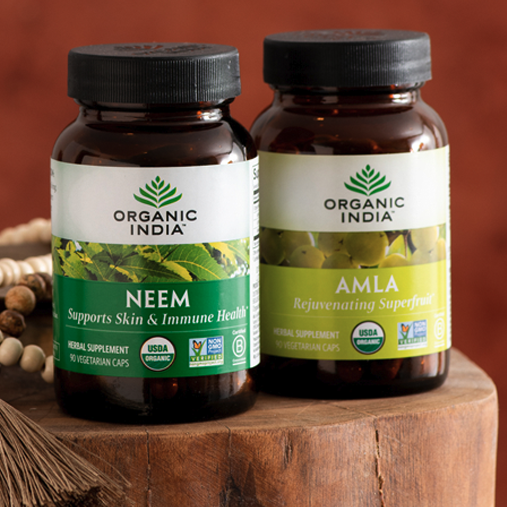






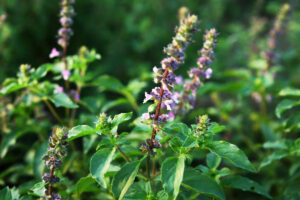
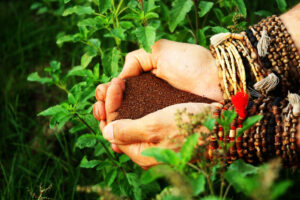




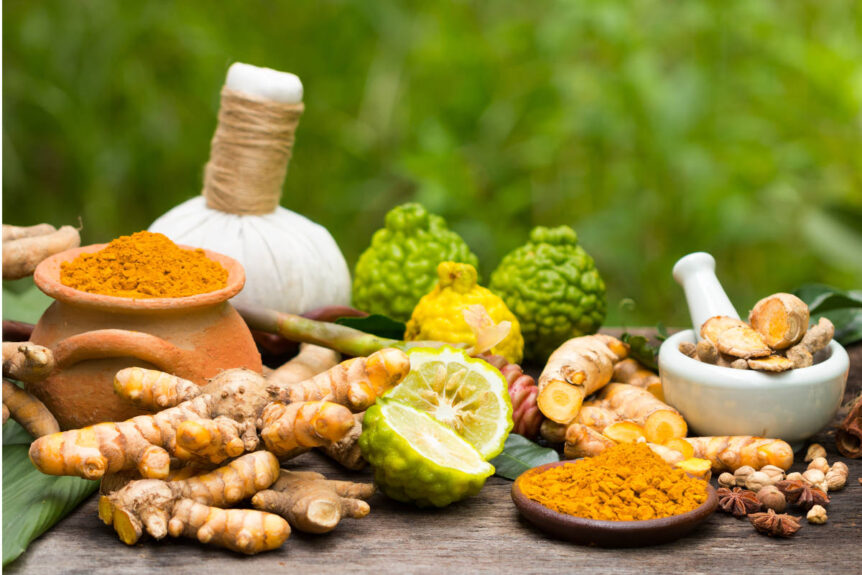
 Kristen Boye is a freelance natural health and green living writer, copywriter, and editor. Kristen was raised on an organic farm in British Columbia which inspired her life’s work. She holds a Bachelor’s Degree in Natural Health, is a Certified Natural Foods Chef, a medicinal herb farmer, natural foods advocate, and is obsessed with writing, homesteading, researching, regenerative agriculture, and words in general. Kristen lives with her husband and two children on their medicinal herb farm in Western North Carolina. Visit her online at:
Kristen Boye is a freelance natural health and green living writer, copywriter, and editor. Kristen was raised on an organic farm in British Columbia which inspired her life’s work. She holds a Bachelor’s Degree in Natural Health, is a Certified Natural Foods Chef, a medicinal herb farmer, natural foods advocate, and is obsessed with writing, homesteading, researching, regenerative agriculture, and words in general. Kristen lives with her husband and two children on their medicinal herb farm in Western North Carolina. Visit her online at: